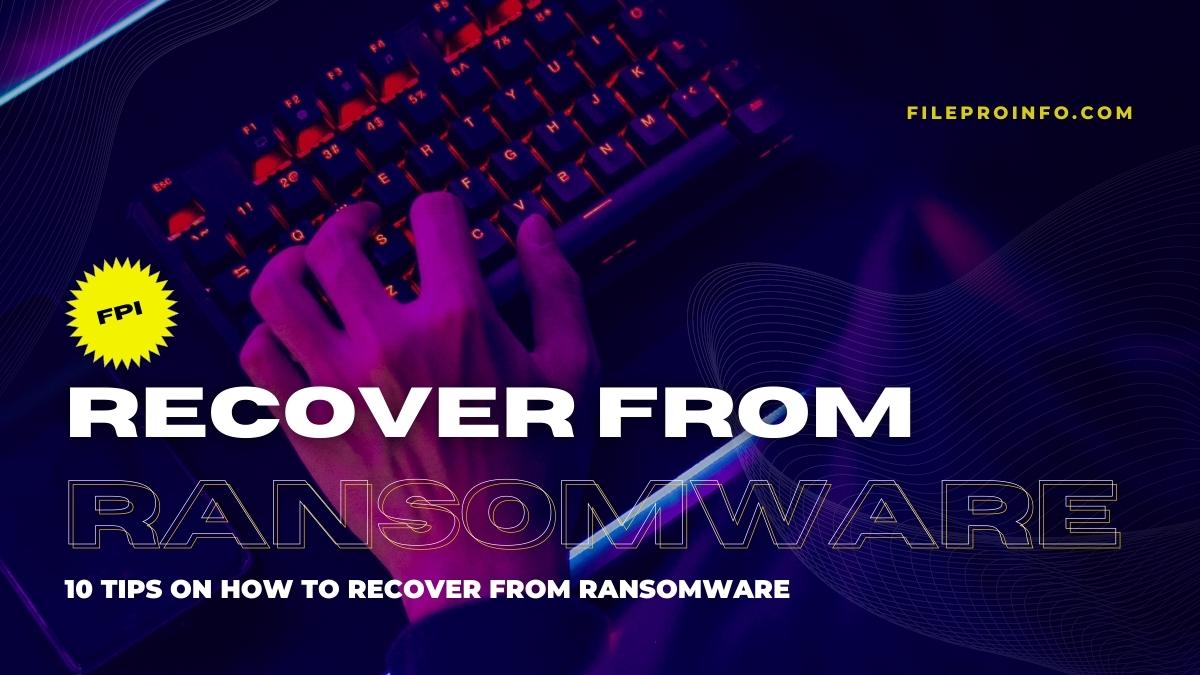
Ransomware is a malicious software attack that takes control of your computer system, encrypts your data, and demands payment for its release. It can be a very frightening experience for anyone who has been affected by it. Fortunately, there are ways to recover from ransomware without paying the ransom. In this article, we will discuss the best methods to ensure you stay safe and secure while recovering from a ransomware attack.
What Is Ransomware?
Ransomware is a type of malicious software (malware) that threatens to publish the victim’s data or block access to it unless a ransom is paid. It has become increasingly common over the years as attackers have found ways to exploit our increasingly connected lives and use ransomware as an effective way to generate profit.
Ransomware works by encrypting files and folders on your computer, making them inaccessible until you pay the attacker for the decryption key. The amount demanded will vary depending on how valuable the data is, but it can range from hundreds to thousands of dollars in virtual currency. Attackers may also demand payment through a third-party service such as PayPal or Western Union. Once payment is received, they will provide instructions on how you can regain access to your files.
Is Ransomware Recovery Possible for a Business?
Ransomware attacks have been on the rise in recent years, leaving businesses vulnerable and unable to access their data. The question many business owners are asking is: Is Ransomware Recovery Possible for a Business? In short, yes- however, it’s important to understand the options available and how to best prepare for a ransomware attack.
To recover from a ransomware attack, businesses must first identify what type of attack they’ve experienced and create an appropriate response plan. If there has been successful encryption of data or files then organizations can look into paying the ransom demand or attempting decryption methods with specialized software. Ultimately, though, businesses must take steps ahead of time to back up any critical data so that if a ransomware attack occurs they will have access to clean copies of their data without needing decryption tools or paying ransoms.
How to Recover from a Ransomware Attack
A step-by-step procedure for recovering from a ransomware attack is provided below:
1. Don’t Panic
Are you facing a ransomware attack? Don’t panic. It’s easy to fall into the trap of believing that all is lost. However, if you know what steps to take, it’s possible to recover from a ransomware attack without any significant financial or data loss.
2. Disconnect Infected Devices
Recovering from a ransomware attack can be difficult, but it is possible. An important first step in the recovery process is to immediately disconnect any infected devices from the network. This will prevent further damage and help keep other assets safe.
Disconnecting an infected device should be done quickly, without warning, and with minimal interaction with the system. This will decrease the chance of malware spreading or additional data being compromised. Once disconnected, a thorough investigation can begin to determine which files are damaged or lost and how best to recover them. The investigation should include security measures such as analyzing logs, hard drive images, and backups to restore encrypted files or systems that have been corrupted by the ransomware attack.
3. Check Other Devices and Servers
When recovering from a ransomware attack, it is important to check other devices and servers to ensure that the infection has been eliminated. Ransomware is a type of malicious software that can spread through networks and quickly infect multiple systems if not addressed promptly. It encrypts files on hard drives, rendering them inaccessible until the victim pays a hefty fee for decryption.
Any device connected to an infected system should be checked as soon as possible to prevent further damage. This includes any other computers or laptops connected through the same network, but also any external storage devices such as USB drives or external HDDs that have been used before the attack happened. Additionally, businesses should scan their servers and databases for any traces of malware left behind by the ransom attackers.
4. Check All Storage Devices for Infection
Are you recovering from a ransomware attack that left your computer systems compromised? If so, it is crucial to make sure the malicious software has been removed from all of your storage devices.
The first step in the recovery process should be to check each device for any signs of infection. This can include scanning with an anti-virus program or manually searching for suspicious files or activities. It is important to note that some ransomware can spread easily between connected drives, so it’s essential to check every single one even if only one device was infected initially.
In addition, don’t forget about any external hard drives or USB sticks as these too could contain ransomware and should be checked during the recovery process. If a storage device is found to contain malicious software, then it must be completely wiped and reformatted before being reconnected to your network.
5. Check for Data Exfiltration
Data exfiltration is an often overlooked, but essential component of recovering from a ransomware attack. Ransomware attacks are usually conducted by hackers who encrypt a user’s data and demand payment in exchange for unlocking it. Regardless of whether or not the ransom is paid, organizations should always check for any data that has been taken during the attack. Data exfiltration can be done through a variety of methods such as emailing out large files, transferring files to external storage devices, or using remote access tools like Remote Desktop Protocol (RDP).
Organizations should take steps to protect their systems and data against potential attackers. This includes having strong security policies in place and conducting regular security audits. Additionally, organizations must monitor web traffic activity for any suspicious activity that could indicate an ongoing data exfiltration attempt.
6. Avoid Paying the Ransom
When it comes to recovering from a ransomware attack, the best advice is to avoid paying the ransom. A ransomware attack occurs when malicious software encrypts files on your computer or network and hackers demand payment for the restoration of those files. While there are instances where paying the ransom is necessary, many times there are better ways to recover from such an attack.
The most important thing in dealing with a ransomware attack is to be prepared beforehand. Developing a backup plan can help ensure that you’re able to recover your data without having to pay any money. Keeping up-to-date backups of all important data can save both time and money if ever faced with this kind of cyber attack.
7. Check Online to Find a Decryption Key
With ransomware attacks quickly on the rise, it is more important than ever for businesses and individuals to know how to recover from a ransomware attack. One of the most effective ways to do so is by checking online for a decryption key.
Decryption keys are unique pieces of data that allow users to unlock their data after it has been encrypted by malicious hackers. These keys can often be found through online resources such as security blogs, malware forums, search engines, and even social media networks dedicated to the sharing of information about cyber-attacks and defense methods. The availability of these resources makes them easily accessible to anyone affected by ransomware or other forms of cybercrime.
In addition to using online resources, users should also take proactive steps such as backing up their data regularly and investing in quality antivirus software to prevent further attacks in the future.
8. Report the Attack to Authorities
When it comes to recovering from a ransomware attack, it is essential to take the proper steps and report the attack to authorities. Ransomware is malicious software that can cause significant damage to computers and networks by holding data hostage until a ransom is paid. By notifying law enforcement, businesses can help protect themselves from future attacks as well as give investigators valuable information about the perpetrator.
The first step in reporting a ransomware attack is determining whether or not you have been victimized. If your computer or network has been compromised, then contact local law enforcement immediately. Make sure you have evidence of the cyberattack and any communication sent by the attacker, such as an email with instructions on how to pay the ransom. Provide this information to law enforcement so they can begin their investigation into the incident.
9. Recover Data
When a business falls victim to ransomware, it’s important to act fast. A ransomware attack is a malicious cyberattack designed to encrypt and hold data hostage in exchange for payment. The best way to ensure that the business can recover from the attack is by taking preventative action ahead of time.
Creating secure backups of valuable data should be one of the top priorities for any business or organization. This allows administrators to quickly restore their systems without having to pay a ransom for their data to be released. It’s also essential that businesses have up-to-date antivirus software installed on all computers and networks, as this can help protect against ransomware attacks and many types of malware attacks.
10. Find out How the Attack Happened
A ransomware attack can be devastating for individuals and businesses alike. It is important to understand the severity of the attack and the steps that need to be taken to recover from it. In this article, we will discuss how to identify a ransomware attack and how best to go about recovering from it.
Ransomware attacks are a type of cybercrime that locks down computers or encrypts files until a ransom is paid by the user. The attacker may threaten to delete data or make it inaccessible if the ransom is not paid in time. Unfortunately, paying the ransom does not guarantee that your data will be restored; therefore, other methods should be considered before making any payments. To protect yourself from further damage, you must first determine how the attack occurred so you can begin taking measures to prevent future attacks.
Can System Recovery Remove Ransomware?
When it comes to ransomware, one of the most pressing questions is whether or not system recovery can help remove it. As this type of malicious software continues to become more sophisticated, many IT professionals are wondering if the traditional approach to data recovery will be enough to combat the threat.
The answer, unfortunately, is that system recovery won’t always be able to remove ransomware. While there are some cases where system recovery tools can detect and remove malicious software, more often than not they will either fail or cause further damage. This is because individual files may be encrypted as part of a ransomware attack which makes them inaccessible even after restoring a system from an earlier backup. Furthermore, any new files created since the last backup may also remain unprotected and vulnerable until removed manually by an IT expert.
Is Ransomware Data Recovery Easy to Do?
Is Ransomware Data Recovery Easy to Do? Ransomware is a type of malicious software that cyber criminals use to encrypt and lock files on a computer. It then demands payment in return for access to the data. It can be extremely damaging as it blocks access to important documents, photos, and other files. So the question remains: Is ransomware data recovery easy to do?
The answer depends on the severity of the attack and how quickly it was detected. If it has been caught early enough, there are recovery tools available that allow users to retrieve their data without paying the ransom demand. However, if too much time has passed before detection or if encryption is particularly strong, then these methods may not be successful in recovering lost data.
How Long Does It Take to Recover from a Ransomware Attack?
When a business or individual is hit with a ransomware attack, it can be overwhelming and disheartening. But the most important question to ask is: how long does it take to recover from a ransomware attack?
The answer depends on several factors, such as the type of ransomware involved, whether backups are available, and how quickly the attack was detected. In some cases, recovery may take weeks or months; in others, it can take days or even hours. The best way to ensure minimal downtime is by having up-to-date backups available and implementing strong security measures to prevent future attacks.
To avoid lengthy recovery times and financial losses due to ransomware attacks, businesses should invest in reliable cybersecurity solutions such as malware protection software and anti-virus programs that can detect threats before they cause any damage.
How Much Does It Cost to Recover from a Ransomware Attack?
Ransomware attacks are one of the most destructive types of cybercrime, costing businesses and individuals millions of dollars every year. Recovering from a successful ransomware attack can be a costly endeavor for those without the right protection in place. Understanding how much it costs to recover from a ransomware attack is essential for business owners and individuals alike.
The cost associated with recovering from a ransomware attack depends on several factors, including the type of malware used and the extent of damage done to an organization’s systems. If backup files are not available or have been destroyed, data must be recovered through professional help which usually requires significant financial resources. The cost may also include fees paid to hackers to unlock encrypted files; these fees may range from hundreds of dollars to thousands or even more depending on the severity of the attack and the level of encryption used by hackers.




